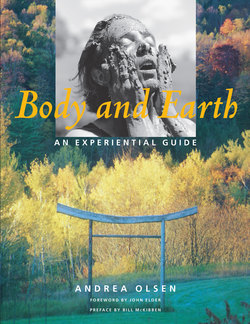Читать книгу Body and Earth - Andrea Olsen - Страница 8
На сайте Литреса книга снята с продажи.
ОглавлениеFOREWORD
JOHN ELDER
In A Sand County Almanac, Aldo Leopold writes, “Land, then, is not merely soil; it is a fountain of energy flowing through a circuit of soils, plants, and animals.” He invites his readers to recognize the life and unity of our planet, rather than to see only a conglomeration of raw materials. For our usual assumption that “soil” is just a “resource,” one more commodity in the marketplace, he wants to substitute a more inclusive and participatory perspective on the “land.” Such a shift broadens our sense of community and prepares for a more mindful and ethical relationship with the rest of the natural world.
In Body and Earth: An Experiential Guide, Andrea Olsen approaches the human body in a way that recalls Leopold’s understanding of the land. The essential insight, for her as for him, is that human beings are included in the living circulation of the earth. “What is out there is in us,” she writes, “and what is in us is out there.” This is not just a metaphor for Olsen. She shows that, through becoming more attuned to the structure and processes of our own bodies, we also have the opportunity to register the balanced wholeness of the world more vividly. Such heightened awareness may move us past abstract concern for “the environment” to a more immediate and physical Identification with the earth.
The Middlebury Bicentennial Series in Environmental Studies takes a bioregional approach. It assumes that nature and culture are best understood in relation to each other, and that their wholeness is most evident within the concrete specificity of a particular bioregion. Andrea Olsen contributes something new and valuable to such a project. She reminds us that a particular watershed must be physically entered, as well as enacted, through our work, our art, and the rhythm of our daily lives before it can become more for us than a mere idea. The body grounds this living “circuit” for her. The vital energy flowing into a human being from the surrounding landscape may surge back out into the world through mindful participation in natural processes.
In fulfilling its role as “an experiential guide,” this book leads its readers through the conduits of the senses. The patterns that organize our own bodies are also found in the other organisms who are our evolutionary kin and in the living earth itself. The Gaia Hypothesis can be tested experimentally, like any other hypothesis, when a researcher systematically collects, refines, and interprets data through the evidence of his or her own senses.
The experiential core of Body and Earth is complemented by the centrality of stories to this distinctive curriculum. Standing at a fertile edge between dance and the environmental sciences, Andrea Olsen often expresses her insights through resonant stories of connection with nature. Tales of the vanished farmscape of her Illinois girlhood and of her family’s annual migrations to Florida become performance texts through which her body can remember its former homes. They also become openings through which she and her readers, including the students who will use this book in environmental studies courses, may move more alertly into the landscapes they currently inhabit. Exercises and stories are complemented, in their turn, by the beautiful photographs associated with them. Such images help to assure that Body and Earth will be experienced on aesthetic and emotional levels as well as on an intellectual plane. In its pursuit of balance within diversity, this is a book that begins and ends in wholeness.
